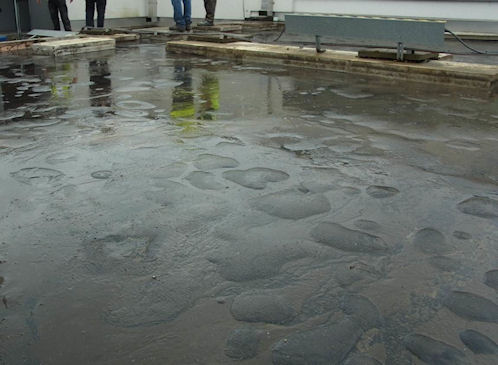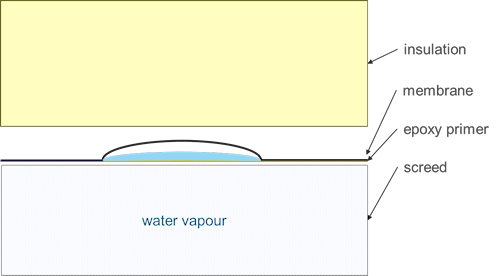Inverted roof defect - case study
An inverted roof, also referred to as a ‘protected membrane’ or ‘upside down’ roof, is where the waterproofing layer is beneath the thermal insulation layer instead of above it. This means that the temperature within the roof void is closer to that of the building’s interior, without a vapour control layer being required as with a warm roof.
BRE investigated a large building with an inverted roof that was suffering from persistent leaks, with water dripping from the underside of the roof and on to suspended ceiling tiles. When the insulation was removed from the worst-affected area, a large number of water-filled ‘blisters’ were found in the waterproof membrane.
The blisters ranged in size from 50 mm to 1 m and further investigations revealed that they were present across the entire building.
[Figure 1 – Water-filled blisters across roof surface revealed by the removal of the insulation boards]
The roof build-up comprised the following elements:
- Ballast.
- Insulation.
- Liquid-applied polyurethane waterproof membrane.
- Epoxy resin primer.
- Concrete screed.
- Pre-cast concrete planks.
The building owners assumed that the blisters had formed because of pinholes and small tears in the membrane, and indeed many such defects were present. However, the majority of the blisters did not contain any defects and there appeared to be no path for water to enter them.
Following an investigation, BRE concluded that water that had been trapped in the roof build-up during construction had condensed between the top of the concrete screed and the underside of the membrane.
The epoxy primer that had been applied to the top of the concrete screed appeared to be acting like a one-way valve, allowing water vapour to pass upwards, but not allowing it to be absorbed back into the screed once it had condensed. This caused the blisters to be ‘pumped up’ with water each time a sudden downpour followed a spell of fine weather.
[Figure 2 – Sketch of condensation within a vapour-filled blister]
It is stressed that this was an unusual occurrence and not one that is normally associated with inverted roofs. Unfortunately the scope of the investigation did not allow BRE to fully investigate the circumstances that had allowed the blisters to form. But the most likely cause was a deficiency in the bond between the liquid-applied waterproof membrane and the primed surface of the concrete screed.
This article was originally published here by BRE.
[edit] Find out more
[edit] Related articles on Designing Buildings Wiki
Featured articles and news
BSRIA Sentinel Clerk of Works Training Case Study
Strengthening expertise to enhance service delivery with integrated cutting-edge industry knowledge.
Impact report from the Supply Chain Sustainability School
Free sustainability skills, training and support delivered to thousands of UK companies to help cut carbon.
The Building Safety Forum at the Installershow 2025
With speakers confirmed for 24 June as part of Building Safety Week.
The UK’s largest air pollution campaign.
Future Homes Standard, now includes solar, but what else?
Will the new standard, due to in the Autumn, go far enough in terms of performance ?
BSRIA Briefing: Cleaner Air, Better tomorrow
A look back at issues relating to inside and outside air quality, discussed during the BSRIA briefing in 2023.
Restoring Abbotsford's hothouse
Bringing the writer Walter Scott's garden to life.
Reflections on the spending review with CIAT.
Retired firefighter cycles world to raise Grenfell funds
Leaving on 14 June 2025 Stephen will raise money for youth and schools through the Grenfell Foundation.
Key points for construction at a glance with industry reactions.
Functionality, visibility and sustainability
The simpler approach to specification.
Architects, architecture, buildings, and inspiration in film
The close ties between makers and the movies, with our long list of suggested viewing.
SELECT three-point plan for action issued to MSPs
Call for Scottish regulation, green skills and recognition of electrotechnical industry as part of a manifesto for Scottish Parliamentary elections.
UCEM becomes the University of the Built Environment
Major milestone in its 106-year history, follows recent merger with London School of Architecture (LSE).
Professional practical experience for Architects in training
The long process to transform the nature of education and professional practical experience in the Architecture profession following recent reports.
A people-first approach to retrofit
Moving away from the destructive paradigm of fabric-first.
New guide for clients launched at Houses of Parliament
'There has never been a more important time for clients to step up and ...ask the right questions'
The impact of recycled slate tiles
Innovation across the decades.
EPC changes for existing buildings
Changes and their context as the new RdSAP methodology comes into use from 15 June.



























